| As we exit the gate of our Condo complex and look up the stairs to EL Centro we see professional camera crews and people milling around some exhibits set up on the stairs. It turns out to be a one-day fashion show by Maria Jose Machado, a local designer. We walk slowly up the stairs stopping to look at each of the approximately 12 exhibits. Some were interesting, but there was nothing that called to me as something I would wear. But then, I am definitely not a fashionista. :-) |
|
0 Comments
 William comes from a line of barbers. His father is a barber. Two uncles on his father's side were barbers. His uncle on his mother's side is a barber and his paternal grandfather was a barber. The number of times he has gotten a haircut from someone other than a relative can be counted on one hand. But here we are in Cuenca, Ecuador without a relative in sight and William in dire need of a haircut. A week or two ago we were sitting in Parque Calderon and two Expat's sitting nearby were discussing haircuts. One proudly stated that there's more expensive places in town, but he goes to a small shop in the alleyway that leads to the rotary plaza and is charged only $2. William also asked our friend Burt where he gets his hair cut. Burt's preferred place is in El Centro and is also charged $2. When walking along Calle Larga we have often passed by a barbershop called "The Original." It's a traditional barbershop complete with the old-fashioned barber chairs and back bars. Early in the day one of the barbers would often be standing outside catching a little fresh air between customers. William decides this is the place to get his haircut!  We walk up to Calle Larga and William pokes his head in the door. There's no one in the chairs and the woman barber welcomes him in. He points to his head and says "pocito", which maybe could have been "solo un poco". She smiles and begins cutting his hair. After a few minutes he wonders if she interpreted his comment as just cut a little off or cut it short, either way it's too late. She takes out a straight raozr to trim around the ears and neck - she's much more wicked with the blade than his father. Twenty minutes later a smiling William emerges from the shop with a nice haircut and $4 less in his pocket. Our first month in Cuenca we booked Casa Rio, a 3+ bedroom, two story condo with a dining table for eight, upscale kitchen appliances and washer and dryer. The condo layout features two master suites with queen beds and also two terraces facing the Rio Tomebamba and Parque de Madre (one on each floor). Other amenities include four TV's with the DirecTV gold package, which has many English-speaking channels, and a building caretaker who will help carry suitcases, etc. when he is on duty. This condo was perfect for our family (4 adults plus us) the first week of our stay and for having our friends Elsie and Charlie visit the last week of our stay. It also allowed us to host dinner parties with our other friends in Cuenca. The only downside of the condo was the 3 stories of stairs to reach the front door. Sunday we sadly say goodby to Casa Rio and move to a condo 3 blocks away across the river. This is a functional condo. It has two bedrooms with full-sized beds which mostly fill the rooms, a small bathroom with toilet and shower, a "great room" that includes the sitting area, dining table for four and kitchenette. There is a 32" flat-screen TV with a DVR and an HDMI cable. No DirecTV or cable TV. We connect the HDMI cable to our laptop or iPad to watch Netflix or US TV through the Internet or movies we have recorded. It's hard to move down in amenities. Last year we stayed at a similar functional condo in the same complex and viewed it "fine". It helped that it was a step up from the one bedroom student-dorm style apartment we had at Apartmentos Otorongo the year before. The cost of the functional condo is 1.5 times Apartmentos Otorongo and Casa Rio is 2 times the functional condo. As the saying goes, you get what you pay for.
The chef at La Warmi, a local restaurant occasionally offers cooking classes. Saturday I joined our friend Burt and two other expats for a course in linguini a la bogole (pasta with clams) and torta de madero con miel (sweet plantain cake).
The chef is Ecudorian and she is able to explain some things in English. To help she has also hired an interpreter. We have fun dicing, chopping, mashing, cooking and baking. After the food is prepared we sit down to enjoy the results of our labor. Museo Pumapungo is one of our favorites for a few reason. The interior provides an overview of the diverse heritage of the people of Ecuador. Behind the museum are the Inca ruins of Tomebamba, which was the north capital of the Inca Empire. Below the ruins the museum has a delightful garden and small bird sanctuary. In addition to all this, there is an small stand in the park which is Waffles de Belgica. Needless to say, cannot wait to take Elsie and Charlie to the museum and enjoy a waffle. We do so on Thursday between rain showers.
I have arranged with Orlando, a local independent tour guide, to take eight of us to Giron and Yunguilla for a day trip on Wednesday. Orlando arrives at our condo on time, and I am pleased that he has a separate driver for the van allowing him to concentrate on getting to know us and telling us about our day. We quickly learn that Orlando lived in New York for four years and in Boston for 12 years. His command of English is significantly better than the guide we had on Sunday. Our first stop is a 45 minute drive where there is a monument commemorating the 1825 Battle of Portente. On a clear day it provides a wide view of the Yunguilla Valley, but unfortunately the fog has rolled in. From here we head to the base of El Chorro waterfall in Giron. El Chorro is one of the longest waterfalls in Ecuador at 102 meters and is located in a cloud forest. It is slightly drizzling as we start our 20 minute walk to the falls. But that doesn't really matter as the spray from El Chorro gets us wet wherever we are not covered by poncho's or raincoats. Following a warm-up drink of canelazo which is warmed water, sugar, cinnamon and sugar-cane liquor, we drive to the town of Giron to visit a small military museum with artifacts from he 1800's. An administrator from the museum describes the guns and tells us the history in Spanish and Orlando translates for us. She shows us on a map how Ecuador has given up land to Peru after some of the wars. On the second level there is a long table and portraits of the men who signed a treaty following the 1829 battle of Tarqui. Soon the administrator runs into another room and reappears with a jacket and hat replicating the uniform of the day. She has Vic put it on. We all smile and take photo's. The driver points the van for Yunguilla. We notice that the elevation is decreasing and the weather is warmer - perhaps 10 degrees F. Giron is 7,000 feet and there are parts of Yunguilla at 5,000 feet. We stop at a small hotel for lunch on the terrace by the pool.
Following lunch we take a loop that goes through the farm and ranch land in her valley. Some of the houses and horse farms are amazing. When we return to Cuenca Evelyn and Burt host all us us for a pizza party at their condo. Fun! 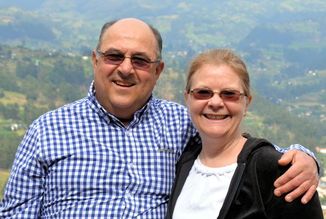 Tuesday Elsie, Charlie, William and I choose to take one of the five walking tours laid out by the Cuenca tourism council. We start at the center of the square at Parque Calderon. On the east side of the square is Inglesia de Sagrario (the Church of the Shire) commonly known as the Old Cathedral, which has been converted to a museum. We enjoy walking through the church/museum which was started in 1557, then turn our sights to the western side of the square and the Catedral de la Immaculada Concepcion, also know as the New Cathedral. Construction of New Cathedral started in 1885 and lasted for almost a century. The cathedral has three giant domes which are covers in blue glazed tile from the Czech Republic. There are also beautiful stained glass windows created by a Spanish artist. We walk a few blocks to the Canari Museum, which unfortunately is closed. Around the corner, however is Museo de las Conceptas. This is a convent which occupies a full city block and is still occupied by the Conceptas nuns. Approximately 25% of the convent has been restored and opened as a museum with paintings, sculptures crosses and dishware which has been donated as dowries over the years. The original buildings were completed from 1682 to 1729. Additional buildings were added in the 1800's. The restoration mostly used the original materials. After a relaxing lunch we walk the seven blocks to 9 de Octubre Market, which is filled with fruits and vegetables on the first floor and butchers and fish mongers on the lower level. Charlie has great fun asking the vendors about some of the fruits and vegetables which are not common in the US. A block further we walk through the Rotary Plaza, which is filled with stalls of selling wood, pottery and tin crafts. William decides to rest on a bench and watch the activity while the three of us shop. Soon their is a slightly inibreated local man trying to make friends with John (unwelcomed). Within a few minutes two security guards from the Rotary Plaza and two Cuenca Policemen are talking to the man and sending him on his way. It is nice to know the authorities are so attentive.
 We wanted to take some side-trips outside of Cuenca with our friends, On a cloudy Sunday six of us (Nanci, Vic, Elsie, Charlie, William and Anne) are picked up outside of the TerraDiversa Travel office at 8:15 am for a trip to Ingapirca. We're joined by Blythe, an administrator of the cultural exchange program of a US university who is in Cuenca for two weeks. As we leave Cuenca our guide Paul explains that we will be taking the Pan-American highway north toward our first stop in Biblian. As we approach Biblian the sky is starting to clear in patches and we are able to see a large church on a hill in the distance. The driver was soon taking the road up to Biblián's Santuario de la Virgen del Rocío. The church is built into the side of a steep rock cliff above the town, and has many staircases to reach from the parking lot up to the church. Along the staircase (and under the church) we find the crypts containing the deceased from the town. The inside of the church is pretty, with some stained glass, however the most interesting part is the exposed rock from the cliff which forms the backdrop to the alter. The views from the church terraces of the surrounding countryside are beautiful. 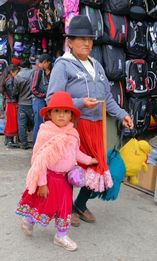 Our next stop is the town of Canari and their Sunday market. The town center is swarming with cars and people. The indigenous people from the region are dressed in their traditional clothing, which makes the market ven more fun. We walk past the stalls selling goods such as clothing, wooden cooking utensils, various tools and bakery. Our guide Paul then points us toward the mercado. We see some of the same fruits and vegetables we find in the mercado in Cuenca. Then we walk past the food stalls where they are selling freshly roasted pig on a spit. William just has to try some of the crisply roasted pig skin. He declares it to be delicious. We all pile back in the van for our ride to Ingapirca. Ingapirca is the ruins of a place of worship for both the Canari and the Inca people's. When the Inca's conquered the region they just took over the sacred site of the Canari and added their own temple of the sun.
Unfortunately the weather turns colder and more and more rainy as we walked through the ruins. At the end of the hour we are all cold and wet, despite having rain gear. Luckily our lunch spot is walking distance from the ruins and we started off with a warmed shot of the local canelazo, which is made from sugar cane liquor. Mmmmm, that's better. With our tummies full and warmed a bit the 90 minute drive back to Cuenca provides an opportunity for more than a few of us to catch a short nap. All agree it is a worthwhile day. 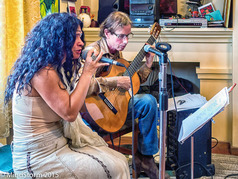 The art culture thrives in Cuenca. In the past few days we have had the pleasure of attending three events. Thursday evening we attended the opening of an exhibition of Tomás Galindo Pazán's latest paintings, which he calls Metachromatics. Tomás gave a short description of his work (in both Spanish and English) and William and I as well as friends Evelyn and Burt enjoyed looking at the 25 paintings, which strongly used colors. Friday we had dinner and enjoyed the music at the Jazz Society. The opening act was a young couple from Argentina - he played guitar and she sang. The second act was an ensemble which included flute, bass, drums and piano. We enjoyed the music, food and the company of our friends Nanci and Vic. Saturday we received an invitation from our Evelyn's art instructor Alberto to attend an open house which was literally in his home. Evelyn, Burt, Nanci, Vic, William and I caught a local city bus to get to the home. In all 25-30 people attended. There was a couple playing guitar and singing (he's Chilean and she's from Cuenca) and they are quite good. Both Alberto and his wife Maíte are painters and their works were on display. In addition a noted ceramicist, Eduardo Segovia was there and presented a number of his works. All of the artists welcomed us warmly. We also had an opportunity to meet people including Chuck from Texas who left it behind to open a craft brewery in Cuenca, and Lorrell, who started the “Top Of The Mountain Yacht Club" for people who sail but now live in Cuenca (three hours to the closest body of water reasonable to sail). William and I also reconnected with Jan, a former administrator of an international school in India, who we met on our first trip to Cuenca. She's now traveling all over South America improving her Spanish and experiencing the cultures of many countries.  Every January 6th Cuenca hosts the Fiesta del los Inocents, a parade to remember when Herod declared that all male children under two years old should be killed. Originally it started out with men dressed in drag to remember that the parents tried to disguise the boys as girls to avoid being killed. Hence, some of the parade officials showed up in drag for the parade. The Amistad Clowns started out the parade at approximately 6:15 pm. Over the years the parade has evolved to have wide-ranging entries. This year we saw "Snow White and the Seven Dwarfs, dancing groups, people costumed as the Cuenca Lightrail, leaders from the America's including Obama, Castro, Rousseff, Maduro, Pope Francis, and Ecuador's own Correa who finished out the pack. Another interesting entry was a procession about a tailor which included women in fairy-tail costumes, a large float with a seamstress operating a giant sewing machine followed by at least 20 people dressed up as spools of thread and balls of yarn. It took up half a city block. We arrived at 5:45pm for the start of the parade, and expected it might be an hour or two long. We were mistaken! At 8:00pm the parade was perhaps half over. Our initial "front row" vantage point along the curb had been overridden by three or four rows of newcomers who just stood in front of us in the street. We were hungry and a bit tired, so we decided to head back toward our condo and find a restaurant along the way. We walked upstream as there were still many Cuencano's headed to the parade, many in costume.
|
AuthorHi. I'm Anne. I wander around the world with William. Enjoy Some of our Favorite Links below
Archives
March 2023
Categories
All
|
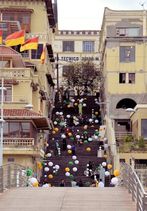





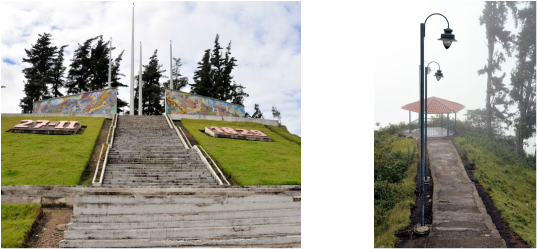
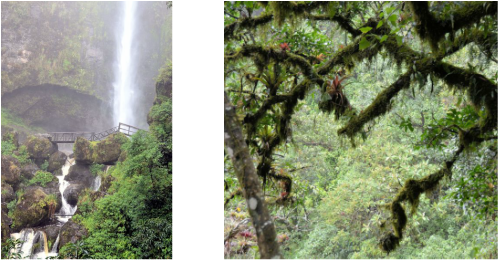
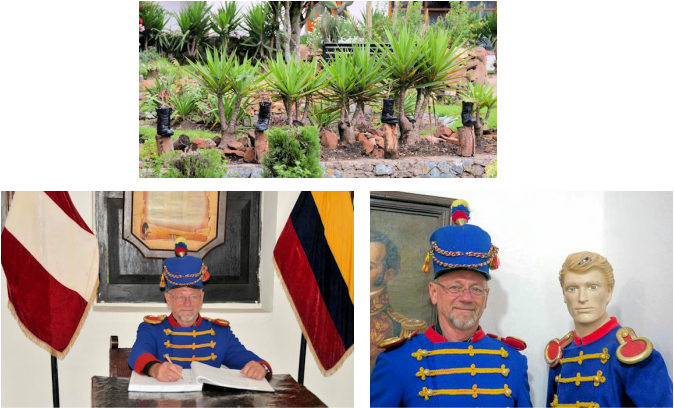





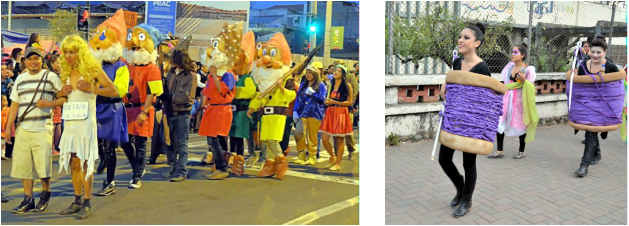



 RSS Feed
RSS Feed